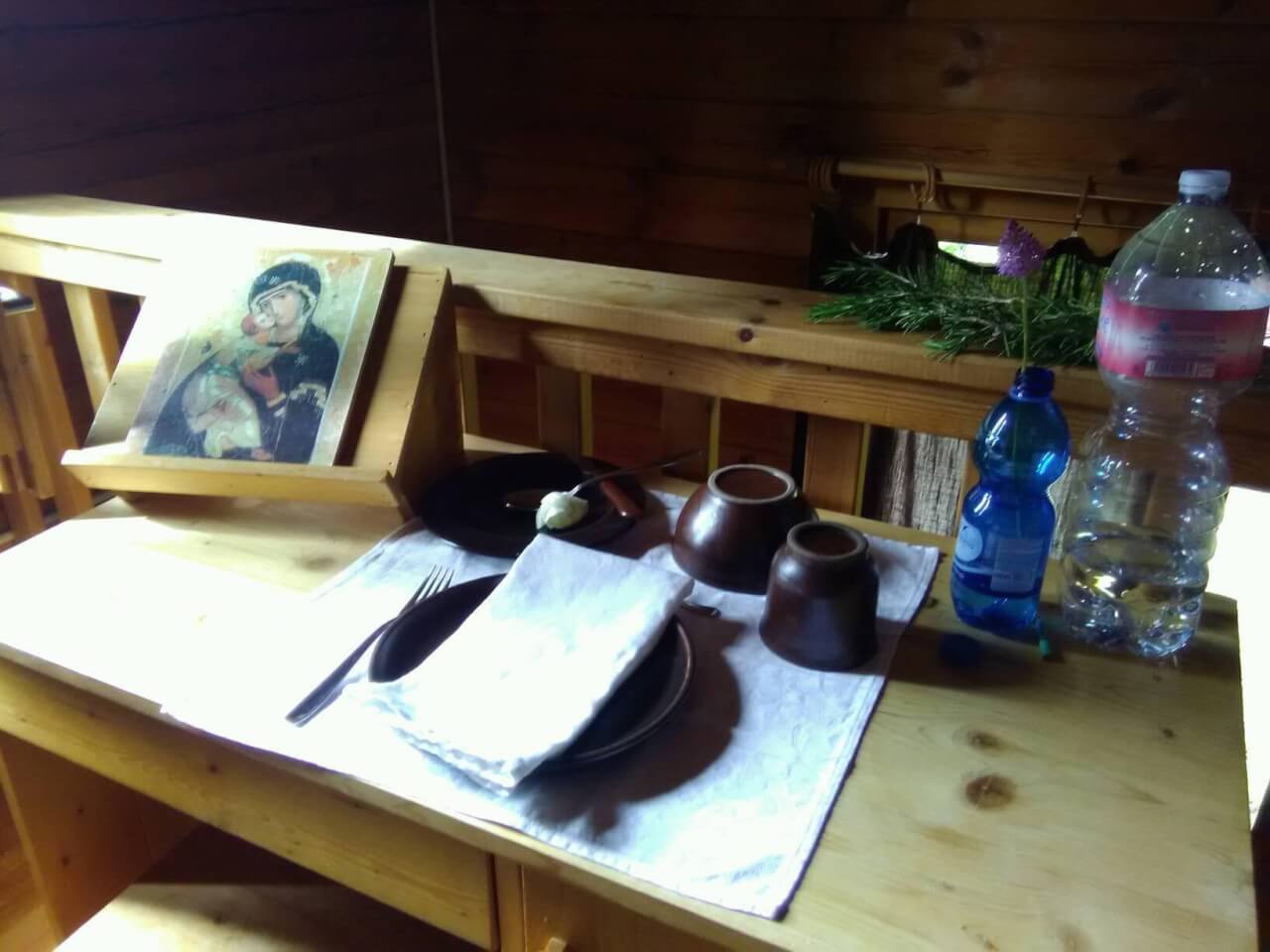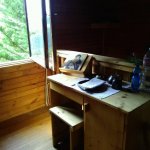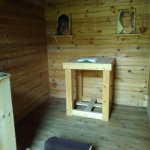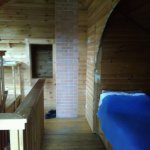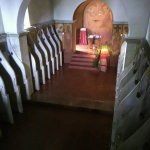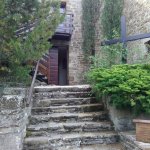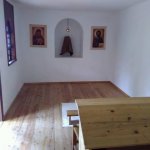Have you ever been to a particularly boisterous and noisy party, and, perhaps getting a bit weary of the noise, slipped off into a quiet room by yourself for a bit and shut the door behind you? Or maybe out into the garden? You can still hear the racket behind you, but it’s distant and you feel for a moment delightfully alone and separated.
I spent last weekend at a monastery – a very, very monastic monastery, obscure and utterly, utterly silent – in the precise middle of exact nowhere, vaguely in the vicinity of the old Umbrian town of Gubbio, of St. Francis and the Wolf fame. This place was rebuilt on top of a small mountain where an ancient hilltop farming village once was. There is little left of the old village now – a place so small that even locals with old family roots have never heard of it.

On Friday morning, I walked out the door and got on a bus, and came after about four hours to the quietest place on earth. Despite my loud and frequent protestations against Modernia, I met with correction of my illusions upon arrival. I asked the extern sister who greets and settles guests if it would be all right to take some pictures of the grounds and buildings for my website. She looked at me quite blankly for a moment and then said, “I’m sorry. I don’t really know what that is. I’m sure it will be OK to take some pictures, but you’ll have to talk to our new sister about the internet. We didn’t have it when I entered.” We were speaking in Italian, which was the first language of neither of us so maybe I simply wasn’t being clear. But I think she simply had no idea what I meant. It was then that I realized that nearly all my objections to Modernia have been voiced on the internet; an irony I was vaguely aware of before, but which may have come completely home to me only at that moment.

This little known area is the home now of a surprisingly successful monastic community, founded in 1950, that is based on the Carthusian model. The monastic Family of Bethlehem, of the Assumption of the Virgin Mary and St. Bruno, has about 30 monasteries around the world – many more than survive today of the original Carthusian order – and unusually, nearly all of them are houses of nuns. They are mostly in France; there is one women’s monastery near Gubbio and a matching men’s monastery in the same general area, near the town of Bastia Umbra, close to where I now live. Umbria has ever been the “cuore verde,” the green heart of Italy and it seems this is especially true in things religious, monastic and mystical. It is still so; Umbrians know that theirs is a place of saints and mystics.

It’s the best time of year; the summer is not advanced so everything except the wheat fields is still green. The warm air is full of the scent of flowers; this is the season of the Tiglia blossom, and the sound of bees. The June wildflowers are blooming, buddleia, columbine, valerian and the late campanulas, as well as the delicate and precious little pink pyramid orchids that are everywhere the sun is. Dawn is about five am, and the birds wake you up well before your alarm. The sun warms the ground beneath the cypresses and alpine cedars, and the scent of summer pine comes in on the breeze through your hermitage windows.

Guests come for silence and solitude and are housed in the same little three-level wooden hermitages as the nuns, each with its high wall and stout wooden door, and the little hutch with a door on either side in which the claustral sister leaves your meals. Each hermitage is a tiny world, complete; walled garden, private oratory and little wood stove for winter, a bed built into an alcove, a tiny bath and a desk next to the window for your meals. Each of the “eremi” are named: I’m in “San Francesco”.
(Note to self: next time stop at a ferramenta in Gubbio and buy mosquito nets and a packet of thumbtacks. No one really has ever been able to explain to me why Italians never, ever have screens on their windows. They dislike mosquitoes as much as we do.)
At seven in the singing morning, you walk slowly up the hill, up the little stone steps and through the locked wooden door that leads out of the guest cloister, and up to the chapel to hear the nuns chant their morning offices and the Mass. Then the day is yours until 5:45 for Vespers. You are shown where the hidden key is for the adoration chapel, and that is where I have been singing my own Offices in solitude. The nuns use some combination of the western and Byzantine rite of Divine Office that I find flatly incomprehensible, though so beautiful that I’m happy to just be carried along it like a boat on a stream.
You can take your passeggiata around the grounds – the cloistered parts of the monastery are clearly labeled and surrounded by high wooden walls, so there’s no chance of accidentally stumbling into the wrong place. There are paths that take you through woods and past fields and down to one of the older hermitages – a prefab they used when the place was first founded and is now used for occasional married guests – where there is a sun shade set up and chairs like a suburban terrace, but with all the grand vista of the mountains in every direction, noble and wild and empty.
You take your meals as the nuns do, at the little desk in the hermitage; in the drawers are an extra cloth napkin, olive oil, a little jar of salt, packets of tea and a tiny electric kettle. The bells ring throughout the day to tell the nuns when it is time to pray their Offices, work, eat and sleep. When you are here, it is the only indication that you are not totally alone with the birds and trees.
For most of the day, apart from Mass and the two Offices, morning and evening, in the monastery chapel, the sisters spend their days, as all Carthusians do, in their hermitages, doing manual and artistic work, reading, praying, resting. They get together once a week for a long walk during which they talk freely – I expect about the things they have read and prayed about the rest of the week. And that is all there is to it.
They make pottery and sacred art, painted and carved icons and statues to sell, and do all their own woodwork, gardening, sewing to make habits, and anything else that is needed. And while they do it, they raise their hearts and minds to the listening God. It is perhaps the quietest life in the world. So much so that when you come to visit, it can be a struggle to relinquish our interior noise – our beloved mental racket – that makes up so much of our daily secular lives and makes us feel important. I read once that the Abbot of La Grande Chartreuse said that it takes a monk ten years to completely “settle into the life.” I can well imagine. What a fight it would be to give up noise.

It is also a place so out of the way that even with my amazing new smarty-smart smart phone I can barely get an intermittent signal. I really had no idea such places still existed in Italy, where the use of “devices” is so universal I’ve begun to wonder if they just issue you a smartphone at birth. Being, essentially, both a modern person and a slacker, I have brought both my phone and my laptop, because… well… because. I can’t help being a writer. The days during which you have only prayer, birdsong, and the book of Renaissance painting you brought with you, can be a bit long, so I’ll admit to occasionally taking a hopeful poke at my phone. Sometimes it flashes to life and, sure enough, there everybody still is, on Facebook and Twitter, still yammering and arguing merrily away, as always. It’s like peeking back into the party from the quiet terrace garden.
I’ve been told that though we aren’t here for life, it really still takes at least a week for guests to lose the rattle and ringing in their minds that the world creates. That frantic sense of being surrounded not only with people but with demands and expectations; and the monastery demonstrates that the expectations are of such little actual moment! One is not only required to do the practical, sensible and necessary things like pay one’s bills, clean the bathroom, dig the weeds and feed the kitties, but to “keep up”. And this means to keep up with everything. With the latest television shows, the jabbering of the late night talks shows, the latest slang and cool-kid, in-crowd internet lingo, the plot details of Game of Thrones or Breaking Bad, or the Walking Dead, the latest superhero films, the latest memes, the latest running jokes… what Luke Skywalker is saying about Donald Trump on Twitter. And heaven help you if you are a week behind! No Boomerposting!
One must know the latest patter of secular politics (in my case this covers four countries and the EU). One must keep track of the latest Islamic outrages, the bombings, the car-rammings, the stabbings and slashings; the useless and cowardly witterings of politicians and churchmen after each day’s blood-smear is hosed away again, cleared up and ready for the next attack. And who is staging counter demonstrations in Poland, in Britain; and then the counter demonstrations to the counter demonstrations, and what the BBC has to say about it. And one must do it every day, because none of that is likely to end soon.
In the Church one must be up to the minute on the daily outrages and all the posturing, blustering pack of heathens; every disaster, every heresy uttered, every act of brutal suppression and dissolution and every response by the (pitifully few, weak and diffident) people fighting back, as the forces of anti-Christ slowly crush and suffocate the Faith out of the Church. One must know the names and positions, backgrounds and histories of every news-making cardinal and bishop who make excuses and create space for them. One must be conversant with the editorial positions of all the various news outlets, magazines and writers, Catholic and secular, as well as the blogs, knowing which are enemies and which are friends, and which can’t make up their minds.
And one must watch it all, every day, unable to do anything to stop it. One must be in a constant condition of hyper-awareness of what is happening on the little screen, and be ready in a moment to pick out the noteworthy bits and have something sensible to say about them. One must try to listen to all of them at the same time; some of them sly and manipulative, some curt and sarcastic, some direct and factual, many of them in a frightening, screaming rage, many suffering from Modernian anti-rationality, a few so blatantly and forthrightly evil it is breathtaking. One must, in short, be constantly locked in a small room with hundreds people all talking and shouting and demanding attention at once, perhaps the worst nightmare imaginable for a natural introvert, a veritable vision of some upper circle of hell.
At one point, I glanced at my phone and Steve had posted something about Cardinal Paglia defending his homoerotic mural in the Terni cathedral – not very far from where I was sitting – with some pretty obvious smug, contemptuous lies. I looked up from the little screen and heard the bell begin to ring for the evening Office, a sound like a stone dropped into a deep and still pond, one that somehow merely enhanced the holy silence without breaking it. I realized something at that moment that was difficult to put into words, but which the great English art critic John Ruskin came close to summarizing once: “Nothing can be beautiful which is not true.”
This … putrid slime issuing from the mouths of these churchmen cannot be the Truth, whatever their rank. Its very ugliness, the repulsive, sneering twist of their mouths when it comes seething out, is enough to tell you. But at that moment, the utterly sublime beauty of holy stillness where I sat contrasted so perfectly with that horror that there could be no further flicker of doubt – if there had been any. The contrast, indeed, showed me maybe a tiny, dim glimpse of what all this looks like from the perspective of heaven.

The Office of Laudes for Saturday:
He found him in the desert
in a place of horror, and vast wilderness.
He led him about and taught him,
and cherished him as the apple of His eye
As the eagle enticeth her young to fly,
and hovereth over them,
So he spread out His wings and too him up
and carried him on His shoulders.
The Lord alone was his leader
and no strange god was at his side.
He brought him into a high land
that he might eat the fruits of the fields…
…
They sacrificed to demons that are not God,
to gods whom they had not known before;
To new ones that only lately came,
whom their fathers never worshipped.
Thou hast forgotten the God that bore thee,
didst not think of the Lord Who created thee…
Gloria Patri et Filio, et Spiritui Sancto…
I can’t join those nuns and live in that separate world all the time. Haven’t got a vocation to the life, and anyway I’m too old. But I know without the slightest doubt that I want to stay close to them, to visit often and drink the water from that living stream as an antidote to the noxious poisons of the world.

